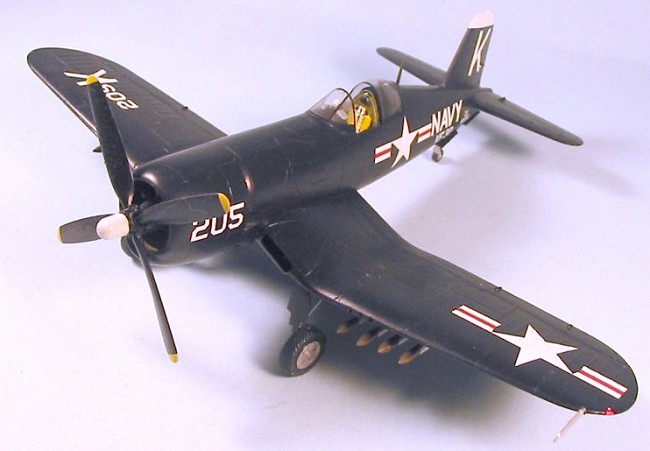
| KIT #: | ? |
| PRICE: | 2800 yen from www.hlj.com |
| DECALS: | Two options |
| REVIEWER: | Tom Cleaver |
| NOTES: |

| HISTORY |
The ultimate Corsair to see service in the Second World War was the F4U-4. The XF4U-4 first flew on April 19, 1944, followed quickly by four other prototypes. The airplane was powered by the R2800-18W, an excellent high-altitude engine that gave the airplane outstanding climb and speed performance up to 35,000 feet, which was what was needed for a fleet defense interceptor, and was equally capable as a fighter-bomber, equipped with two 1,000 lb. bombs or eight 5 inch HVARs. With a top speed of 446 mph at 26,000 feet - a 50 mph improvement over the F4U-1D at the same altitude (the F4U-1D's best rated altitude was 20,000 feet), the F4U-4 was competitive with any other fighter in the world. Production models began arriving in late 1944, and 1,856 had been delivered by the end of the war in August, 1945. The last of 2,056 was delivered in April 1946, and the F4U-4 became the standard fighter-bomber of both the Navy and the Marines in the post-war years.
The Korean War was where the F4U-4 really shined. Operated by both Navy and Marine squadrons from carriers ranging along the Korean peninsula, as well as on land by the Marines, the F4U-4 Corsair was in action from the first day to the last of the war, providing the definition of "close air support" to UN forces.
Tom Hudner and Jesse L. Brown, Jr.:
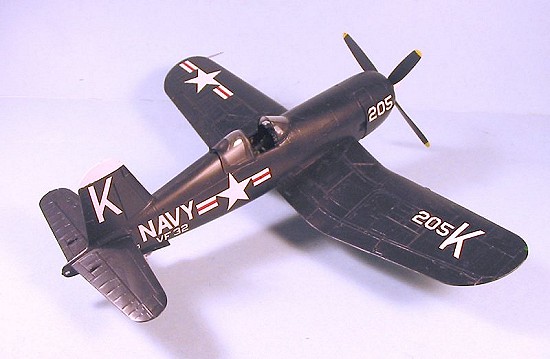 One of the most
poignant tales of the Korean War is that of Lt.(j.g.) Thomas J. Hudner,
Jr., and Ensign Jesse L. Brown, Jr., fellow Corsair pilots in VF-32. Their
story is inextricably woven into one of the greatest tales of Americans in
war, the breakout by the 1st Marine Division from the Chosin
Reservoir and retreat to Hungnam in November-December 1950 following the
Red Chinese intervention in the Korean War.
One of the most
poignant tales of the Korean War is that of Lt.(j.g.) Thomas J. Hudner,
Jr., and Ensign Jesse L. Brown, Jr., fellow Corsair pilots in VF-32. Their
story is inextricably woven into one of the greatest tales of Americans in
war, the breakout by the 1st Marine Division from the Chosin
Reservoir and retreat to Hungnam in November-December 1950 following the
Red Chinese intervention in the Korean War.
Tom Hudner graduated from the U.S. Naval Academy in 1946; the scion of Boston Brahmin Abolitionists immediately entered flight training, becoming a Naval Aviator in late 1947.
Jesse L. Brown Jr. had a more difficult route into the ranks of Naval Aviators. Enrolled in the Navy in late 1946, he became the first African-American to wear the Wings of Gold when he graduated at Pensacola in 1948. The Navy was at that time perhaps the least socially-progressive of all the American armed forces, with a career officer corps that was primarily Southern, and Brown had his job cut out for him to gain acceptance.
Both Hudner and Brown found themselves assigned to VF-3, flying F8F-1 Bearcats off the old U.S.S. "Ranger" during her last year of service. Brown was recognized as the best pilot in the squadron - whether all his squadron mates wanted to admit it or not - when he took a wave-off at the last moment, added throttle just too rapidly (easy to do in the Bearcat) and survived a torque roll less than 100 feet above the carrier deck, from which he recovered in full view of everyone and then made a textbook landing, cool as could be.
In late 1949, VF-3 was divided in three, becoming VF-31, VF-32 and VF-33. While VF-31 went on to transition to the F9F-2 Panther, VF-32 and VF-33 transitioned to F4U-4 Corsairs and took up the fighter-bomber role. With VA-34 assigned, the four squadrons made up the air group of the U.S.S. "Leyte," one of the last of the wartime "Essex" carriers to be commissioned, joining the carrier for a cruise to the Mediterranean with the Sixth Fleet in late 1949 and through the spring of 1950.
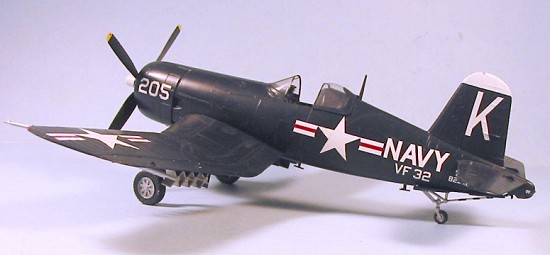 With the
outbreak of the Korean War in June 1950, the "Leyte" transited the Suez
Canal and crossed the Indian Ocean to join the Seventh Fleet in Japan, just
in time to take part in the invasion of Inchon on September 15. From then
on, the carrier did tours in the Sea of Japan with Task Force 77, providing
close air support to the Marines of the 1st Division in their
push up the east coast of the Korean peninsula as UN Supreme Commander
Douglas MacArthur made the fateful decision to cross the 38th
Parallel and "roll back" the Communists.
With the
outbreak of the Korean War in June 1950, the "Leyte" transited the Suez
Canal and crossed the Indian Ocean to join the Seventh Fleet in Japan, just
in time to take part in the invasion of Inchon on September 15. From then
on, the carrier did tours in the Sea of Japan with Task Force 77, providing
close air support to the Marines of the 1st Division in their
push up the east coast of the Korean peninsula as UN Supreme Commander
Douglas MacArthur made the fateful decision to cross the 38th
Parallel and "roll back" the Communists.
By early November, the squadrons from the "Leyte" were aware that the Chinese warnings about UN forces approaching the Yalu River that formed the Chinese-Korean border were not mere bluster as they saw evidence of the now-frozen river being crossed by numerous large units. The Marines arrived at the Chosin Reservoir in the high country the second week of November after encountering fresh enemy troops that they were able to identify as Chinese.
Despite warnings from both the Marines on the east coast of Korea and 8th Army on the western side of the peninsula that they were encountering the Chinese Army in combat, Douglas MacArthur not only discounted the reports but stated for the record in a press conference at his Tokyo headquarters on November 12, 1950 that the Chinese threats to enter the war were not to be taken seriously since the Chinese leadership was aware it was a historical fact that Chinese troops had never been able to stand up against well-trained Western armies. He went further and promised America that "the boys will be home by Christmas," with Korea liberated from the Communists.
On November 24, 1950 - Thanksgiving - the Marines at Hagaru-ri, Koto-ri and Yudam-ni in the region of the Chosin Reservoir looked forward to MacArthur's promised "hot turkey dinner for every man in Korea." They were disappointed when served hacked-apart frozen turkeys boiled but still-half-frozen in the bitter North Korean cold.
1st Marine Division Commanding General O.P. Smith, a veteran of Belleau Wood, Nicaragua, Guadalcanal and Saipan, knew that if MacArthur's intelligence was wrong - and he believed it was from the reports he had first-hand about combat during the approach to the Reservoir - his Marines were in trouble. The heart of Smith's problem was Toktong Pass, the critical choke point between the two forward regiments at the Reservoir and the rest of the division south of the pass. If the enemy took that, the spearhead - 10,000 men of 5th and 7th Regiments, two-thirds of the Division - would be cut off and surrounded. Smith decided to "bar the door" as best he could.
The only unit available was Fox Company, 7th Regiment - 220 reservists called to active duty in July and given three weeks to train together before shipping out for Japan - who had been a hard-luck outfit since the Inchon invasion when the company commander died accidentally. Smith sent Fox Company the best he could: Captain William E. Barber, Jr. Barber was a veteran of the invasion of Iwo Jima, where he was promoted to 1st Lt. and became company commander due to battlefield deaths in 10 days of combat. The men hated Barber that Thanksgiving morning when he ordered them to shave in cold water and "look like Marines." Late that afternoon, they were trucked four miles up the road from Hagaru-ri and dropped off at the base of the commanding height of Toktong Pass. As machine-gunner Bob Ezell later recalled, "The hill was frozen so hard we couldn't blast foxholes with dynamite."
During the early morning hours of November 25, the worst Siberian blizzard in a century swept over the Korean peninsula, dropping temperatures lower than minus-30 degrees Fahrenheit, coating everything with heavy snow.
 For the next three
days, Marines throughout the Reservoir - but most particularly on the
exposed crest of Toktong Pass - fought frostbite fully-clothed in their
sleeping bags. Task Force 77 - including the "Leyte" - plowed the
storm-tossed Sea of Japan with flight ops canceled and more than a foot of
snow on the decks.
For the next three
days, Marines throughout the Reservoir - but most particularly on the
exposed crest of Toktong Pass - fought frostbite fully-clothed in their
sleeping bags. Task Force 77 - including the "Leyte" - plowed the
storm-tossed Sea of Japan with flight ops canceled and more than a foot of
snow on the decks.
At dusk on November 28, the storm finally ended. At 2200, bugles blared out of the frozen darkness throughout the Chosin Reservoir as the Chinese Fourth Army, commanded by Marshal Lin Piao - the liberator of Beijing during the Chinese Civil War - struck every Marine position from Yudam-ni in the Reservoir to Koto-ri. The Fourth Army was composed of 120,000 hardened veterans of the Civil War in ten divisions; their orders were: "Wipe out the Marines to the last man."
That first night, Fox Company lost 60 men in hand-to-hand fighting, but held by the skin of their teeth, inspired by PFC Hector Cafferata who personally killed 38 of the enemy fighting in his stocking feet while his blinded buddy reloaded rifles for him; Cafferata later lost all his toes and part of his right foot to frostbite. At dawn, the Marines were out of ammo, with the survivors of the 1,500-man assault battalion that hit them massing at the bottom of the hill for a final charge. Aussie P-51s of 77 Squadron saved them with a strafing run. An hour later, ammo was dropped - into No Man's Land. With a flight of Corsairs from VF-32 overhead, they retrieved the ammo and began to "sandbag" their positions with the frozen bodies of their enemy.
At Yudam-ni in the Reservoir, 5th and 7th Regiments managed to withstand the assault and keep the high ground. By December 1, the two regiments of Marines at Yudam-ni had managed to defeat two Chinese Divisions and were ready to retreat - if Toktong Pass was open. After two more nights of hand-to-hand combat, Fox Company was down to 85 effectives, all wounded. The Marines in the Reservoir got the message for help. If Fox couldn't hold the pass, nothing else mattered. That night, Lt. Col. Raymond G. Davis, CO 1st Battalion, 7th Regiment, got his orders: form a "scratch" battalion of 600 men - cooks, bakers and clerks, "every Marine is a rifleman first" - then head out cross-country, through the Chinese, and rescue Fox Company. Davis estimated it would take a day to get the four miles to Fox Hill; in the end, it took 72 hours of continuous combat in waist-deep snow and temperatures of minus 20-30 degrees Fahrenheit, taking 350 killed and wounded of the original 600, to accomplish the mission.
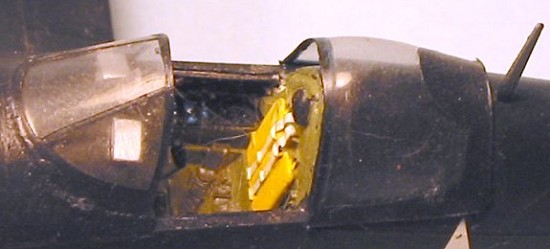 Aboard the "Leyte,"
the pilots of all four squadrons flew multiple sorties in bad sea
conditions with blowing snowstorms over the task force for the next four
days as they gave support to the Marines, most particularly those at
Toktong Pass.
Aboard the "Leyte,"
the pilots of all four squadrons flew multiple sorties in bad sea
conditions with blowing snowstorms over the task force for the next four
days as they gave support to the Marines, most particularly those at
Toktong Pass.
Captain Barber was wounded in his right leg in the first night's battle. During the second night of hand-to-hand combat with a second Chinese assault battalion that launched "human wave" attacks, he brought the survivors of First Platoon off the exposed West Ridge where they were holding and managed to group his force, now down to 95 effectives and 80 men too badly wounded to fight, on the central height, during which he was wounded in his other leg. The third dawn, he was dragged on his stretcher from position to position to personally rally the men.
The third night on Toktong Pass was bad, but not as bad as the first night. By the morning of December 3, they were down to 62 men, crouched in their sleeping bags behind positions sandbagged with the dead of four Chinese assault battalions that crested and failed atop the hill; 45 years later, PFC Fred Gonzales would not be able to rid his mind of the memory of fighting behind a pile of frozen dead. As he recalled, "...no one was in good enough shape to go out into No Man's Land for the morning ammo drop." They were down to 15 rounds per man, and no one expected to survive the coming night, but it turned out to be the lightest fighting of the battle.
At dawn on December 4, Ray Davis could see "Fox Hill," 1,000 yards away. The Chinese had been too busy with his force the past night to attack Barber's survivors.
VF-32 covered the link-up, strafing the field ahead of Davis' men.
 Jesse Brown felt
the bullet strike in his engine and zoomed into the sky trailing white
smoke as the engine seized. Too low to bail out, he managed to crash in a
snow-covered field a few miles from the Marines. The others in his flight
circled overhead, but he didn't get out, and the plane was still smoking.
Jesse Brown felt
the bullet strike in his engine and zoomed into the sky trailing white
smoke as the engine seized. Too low to bail out, he managed to crash in a
snow-covered field a few miles from the Marines. The others in his flight
circled overhead, but he didn't get out, and the plane was still smoking.
Tom Hudner knew his friend was in trouble. As he recalled, he made up his mind in an instant. "I'm going in," he radioed. As he set up for a wheels-up landing, he remembered telling himself, "This is really stupid, you know?"
The others watched him deliberately crash land his Corsair on the same field. "I sledded across the field, entirely out of control and certain I was going to die, before coming to a shaky stop 80 yards from Jesse." He climbed out, shaken. As he recalled, "The snow was waist-deep, it was colder than I have ever experienced anywhere else, and at first I couldn't move. It took me over 30 minutes to cover the distance to Jesse's airplane, and I was damn near frozen stiff by the time I got there."
Once at Brown's Corsair, Hudner discovered his friend's legs crushed in the crash, and that it was impossible to pull him out of the cockpit because the fuselage had broken in such a way he was jammed in the cockpit. The Corsair was still smoking. Hudner piled snow on the cowling to try and stop the flames. Brown's loss of blood had him going in and out of consciousness as Hudner fought to free him.
The sun was going down and it was getting even colder. Hudner ripped at the instrument panel unsuccessfully to pry Brown loose. Finally, a Marine helicopter arrived in the last light of day. Hudner and the pilot tried to break the plane open with a fire axe. Just at dusk, when he had to go or die of frostbite himself, Hudner realized his friend had frozen to death in the cockpit.
As Hudner was fighting to save Jesse Brown, the lead elements of the 5th Regiment reached Toktong Pass. 62 Marines, all wounded, and the dead, were taken onto the trucks and set off for Hagaru-ri. Fox Company had taken 100 percent casualties, killed and wounded - the bloodiest small-unit action in American military history. Their stand at Toktong Pass had allowed the First Marine Division to execute what has been called the most stunning retreat in the face of enemy opposition since Xenophon and The Ten Thousand Greeks marched out of Persia two and a half millennia ago.
Despite Douglas MacArthur's retrograde 19th century view of Chinese armies, the Chinese attack against the UN Forces in November-December 1950 is considered by most military historians who have studied the event to be "the most thorough defeat of a previously-victorious army in recorded history" as Martin Gilbert put it in his magnificent "The Korean War."
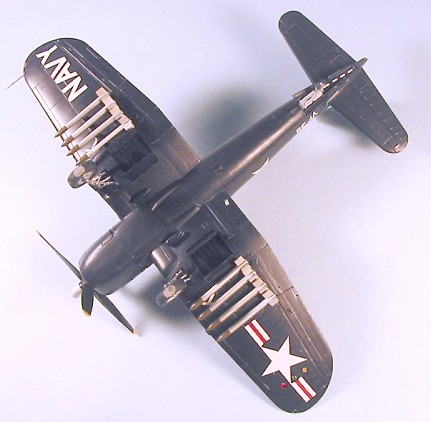 The Marine Corps
in their official history, "The Chosin Campaign," say:
The Marine Corps
in their official history, "The Chosin Campaign," say:
"The road - if an oxcart path can be called such - began at Hungnam, where the Songchan River flows into the Sea of Japan. From Hungnam to Hamhung is eight miles; from Hamhung to Sudong is twenty-nine miles, through Funchilin Pass - which rises thirty-five hundred feet in eight miles; from Sudong to Chinhung-ni, six miles; from Chinhung-ni to Koto-ri in the high country, ten miles; from Koto-ri across the plateau to Hagaru-ri, ten miles; from Hagaru-ri through Toktong Pass at an elevation of five thousand feet to Yudam-ni - on the west side of the north end of the Chosin Reservoir - fourteen miles.
"Not a mile was easy. The road was narrow and winding. Of dirt and gravel, oxcarts had a hard time passing, let alone tanks, trucks and artillery. At times, it seemed to go straight up; at others, straight down. And always around a hairpin curve where a roadblock could be waiting.
"Breaking out from the Chosin Reservoir to Hungnam cost the United States Marines two hundred men per mile. It was The Corps' finest hour."
Private Ernie Gonzales (no relation to Fred), at just 18 the youngest member of Fox Company, later wrote in his journal:
"Why did we do it? The unthinking will say it was for love of home and country. The stupid politicians will say they were fighting for the Free World. The sheltered clergyman will say they were fighting to preserve the Christian way of life. None of these pat phrases comes close.
"The fire of patriotism dies quickly. It is cold by the time the band stops playing and the flags are furled and the voices of the cheering multitudes are faint in the distance. By the time the rifleman gets to the battlefield, all the fanfare and cheering is forgotten. All that remains is a suspicion that the hysteria of the send-off was manufactured so that the stay-at-homes would buy another bond or give another pint of blood.
"The men of Fox Company were not kept in the line of fire by patriotism. The men of my company fought and died at Toktong Pass because we were Marines. We did it for each other."
When the First Marine Division finally arrived back in Hungnam on December 11, 1950, they had suffered 4,418 killed or wounded, and 7,230 cases of frostbite, from a total of 15,000. They brought out all of the wounded and most of the dead, leaving nothing usable; 24,000 Korean refugees accompanied them out as they fled to South Korea. My former father-in-law - one of the "Frozen Chosen" as the survivors call themselves - once told me how the frozen dead were wrapped around the artillery and tank barrels to bring them out.
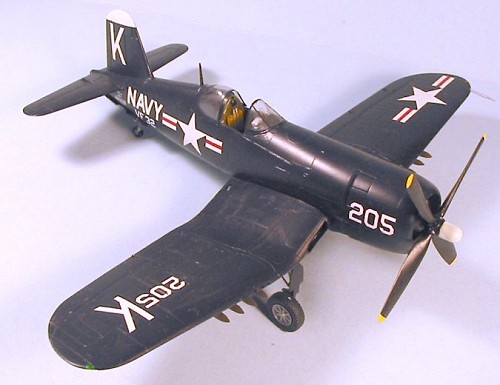 The Chinese
Fourth Army suffered an estimated 43,500 casualties, including 28,000 dead
and 15,500 wounded, most of whom froze to death.
The Chinese
Fourth Army suffered an estimated 43,500 casualties, including 28,000 dead
and 15,500 wounded, most of whom froze to death.
While the Marines retreated from Chosin in good order, the U.S. 8th Army in western North Korea was completely routed in the greatest defeat of American arms in U.S. history. The Army suffered 55 percent casualties, and abandoned most of their wounded to die or become POWs for the remainder of the war, while abandoning the majority of their equipment.
In March, 1952, LT(j.g.) Thomas J. Hudner Jr. became the only member of the U.S. Navy to be awarded the Medal of Honor during the Korean War for his willingness to risk his life in deliberately crash landing to save his friend.
14 Medals of Honor were won at Chosin, more than any other battle in American history, along with 70 Navy Crosses, most of which were awarded in lieu of the original nomination for a Medal of Honor. Additionally, two Victoria Crosses were won by the C.O. and Sergeant Major of 40 Commando, Royal Marines, for "the death ride through Hellfire Valley" in which they ran ammunition from Koto-ri to Hagaru-ri on the second day to hold the crucial airstrip, at a cost of half the men in the unit. Hudner's was one of four Medals of Honor awarded for the battle at Toktong Pass - the others went to Captain William Barber, Jr., Lt. Colonel Ray Davis, and PFC Hector Cafferata.
In April 1969, African-American sailors rioted at several U.S. Navy bases over their treatment during the Vietnam War. Chief of Naval Operations Admiral Elmo Zumwalt called Captain Thomas Hudner to the Pentagon and commissioned him to visit the bases where the riots had occurred, to establish the facts of the situation and institute changes to "promote justice." Hudner's appearance at the bases brought order, because his story was known to the African-American sailors. His reforms revolutionized the Navy and formed the basis for racial reforms in all the armed forces that have created the situation where - today - the American military is the one place in American society where the ideal of racial equality is reality. Admiral Zumwalt later declared that "there was no other senior officer in the Navy with the moral authority to undertake what Hudner accomplished." 23 years later, Tom Hudner told me that he was prouder of what he had accomplished in 1969 than anything he had done in combat.
 William E.
Barber, Jr., rose to Colonel and commanded the first Marine unit to land
at DaNang in April, 1965, signaling the beginning of full-scale American
combat participation in the Vietnam War.
William E.
Barber, Jr., rose to Colonel and commanded the first Marine unit to land
at DaNang in April, 1965, signaling the beginning of full-scale American
combat participation in the Vietnam War.
Raymond G. Davis commanded the Third Marine Division in 1968 during Tet and the Battle of Hue, and was later Deputy Commandant of the Marine Corps.
In 1969, Marshal Lin Piao - by then Defense Minister of the People's Republic of China - attempted a coup against Mao Tse-tung to stop the insanity of "The Great Proletarian Cultural Revolution." When the coup failed, Lin Piao fled toward the Soviet Union with his family. His airplane was shot down and destroyed over Mongolia.
Fred Gonzales, from Long Beach, California, and Ernie Gonzales, from East L.A., met in Korea when Ernie was assigned to Fox Company two weeks before the battle of Toktong Pass, where they fought together. They and their families have shared Thanksgiving dinner with all the trimmings for the past 54 years.
| THE KIT |
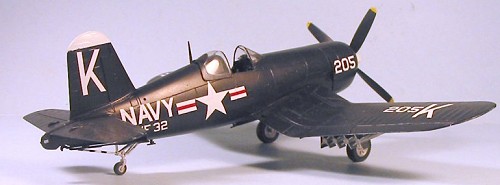 Hasegawa released
their F4U-4 in 1981, a remarkable 24 years ago, and has been periodically
re-released over the years. It was light years' better than the Monogram
F4U-4 released in 1967, and also better than the copy made from it by
Academy in 1987. As a state-of-the-art kit in 1981, it suffers from age
today, with raised panel lines and a very basic cockpit, though it is
accurate in outline and dimensions. It would be wonderful if Hasegawa were
to update the F4U-4 as they have their N1K2-J Shiden-Kai that was released
at about the same time as this kit. (As a side note, from my
understanding, the Hasegawa F4U-4, older Frank, and Ki-27 are actually
older than 1981 as these kits were bought from another Japanese company
[I'm thinking Mania] that went out of business so are not originally
Hasegawa molds. Ed)
Hasegawa released
their F4U-4 in 1981, a remarkable 24 years ago, and has been periodically
re-released over the years. It was light years' better than the Monogram
F4U-4 released in 1967, and also better than the copy made from it by
Academy in 1987. As a state-of-the-art kit in 1981, it suffers from age
today, with raised panel lines and a very basic cockpit, though it is
accurate in outline and dimensions. It would be wonderful if Hasegawa were
to update the F4U-4 as they have their N1K2-J Shiden-Kai that was released
at about the same time as this kit. (As a side note, from my
understanding, the Hasegawa F4U-4, older Frank, and Ki-27 are actually
older than 1981 as these kits were bought from another Japanese company
[I'm thinking Mania] that went out of business so are not originally
Hasegawa molds. Ed)
However, with the Squadron (Falcon) vacuformed canopy and the True Details resin cockpit, and any of the many aftermarket decal sheets that have appeared over the years, this kit can still be made into a good-looking model. I decided to do Tom Hudner's F4U-4 - which I had long wanted to do - when Cutting Edge released a decal sheet for both this airplane and the Corsair flown by Jesse Brown last year.
| CONSTRUCTION |
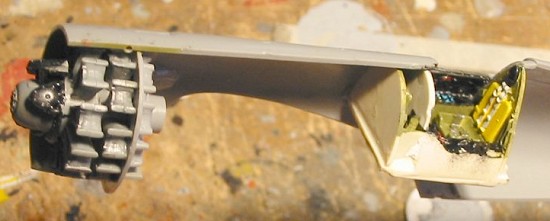 The kit is very
easy to construct. I used the True Details cockpit, which was the first
thing I worked on. Once this had been test-fitted, painted and detailed, I
glued it into the fuselage half and assembled the fuselage after I first
put a firewall made from the kit engine in the cowling, and installed an
R-2800 engine from an old Monogram kit salvaged from the spare parts bin
since the engine provided in the kit is the poorest part of the whole
thing.
The kit is very
easy to construct. I used the True Details cockpit, which was the first
thing I worked on. Once this had been test-fitted, painted and detailed, I
glued it into the fuselage half and assembled the fuselage after I first
put a firewall made from the kit engine in the cowling, and installed an
R-2800 engine from an old Monogram kit salvaged from the spare parts bin
since the engine provided in the kit is the poorest part of the whole
thing.
The wings are an easy sub-assembly, followed by the horizontal stabilizers. With the model assembled, I used Mr. Surfacer 500 to get rid of the centerline seam and then rescribed the panel lines.
| COLORS & MARKINGS |
Painting:
The F4U-4 comes from that period of U.S. Navy airplanes that is very easy to paint: overall Glossy Sea Blue with the landing gear painted aluminum. I used Xtracrylix "Glossy Sea Blue," which I think is the best rendition of this color available, and painted the landing gear with SNJ Aluminum, which stands in well for aluminum lacquer. When the paint was dry, I gave the model a coat Xtracrylix Gloss varnish.
Decals:
The Cutting Edge decals went down with no problem. When they were dry, I washed the model to get rid of dried setting solution, then gave the model a coat of Xtracrylix Satin Varnish overall.
| FINAL CONSTRUCTION |
I attached the landing gear, and the vacuformed canopy, which I cut apart and posed open. The underwing rocket rails came from a Tamiya F4U-1D kit, and the rockets from a Hasegawa P-38.
| CONCLUSIONS |
The Medal of Honor is awarded for "valor above and beyond the call of duty." Tom Hudner could have orbited Jesse Brown's crash site with the others till his fuel supply forced him to return with them to their carrier, and no one would have thought badly of him. Instead, he answered to the old injunction, "Greater love hath no man than he would give up his own life for that of his friend." Having been fortunate enough to meet this remarkable man, this model of his airplane commands a pride of place in my collection.
Review kit courtesy of HobbyLink Japan - www.hlj.com
September 2005
| REFERENCES |
Interview with CAPT Thomas J. Hudner, Jr. USN (Ret), VF-32, April 1992.
Interview with Col. William E. Barber, Jr., USMC (Ret), Fox Company, February 1995.
Interview with GEN Raymond G. Davis, USMC (Ret), 7th Regiment, March 1995.
Interview with CPL Robert Ezell, USMC (Ret), Fox Company, March 1993.
Interview with PVT Ernie Gonzales, USMC (Ret), Fox Company, March 1993.
Interview with PFC Fred Gonzales, USMC (Ret), Fox Company, March 1993.
If you would like your product reviewed fairly and fairly quickly, please contact the editor or see other details in the Note to Contributors.